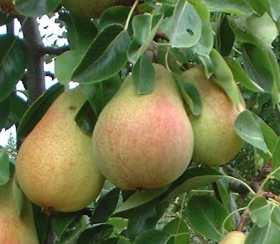How to Grow Pears – A Guide to Growing Pears
 Pears are similar to apples from a growing point of view, except that they flower earlier which does mean they are more at risk from late frosts. There are two basic types of pear – those suitable as dessert pears and those for cooking. Some varieties, such as minarets, are suitable for growing in a large pot, with the advantage that it may be easier to provide the tree with shelter.
Pears are similar to apples from a growing point of view, except that they flower earlier which does mean they are more at risk from late frosts. There are two basic types of pear – those suitable as dessert pears and those for cooking. Some varieties, such as minarets, are suitable for growing in a large pot, with the advantage that it may be easier to provide the tree with shelter.
Pears
Plant bare rooted trees in autumn while the soil is still warm and the tree dormant; container grown trees may be planted at any time of year as long as the soil is not frozen or completely sodden. Harvest August–October, depending on the variety.
Growing Pears
- Pear trees flower early so they need a sheltered situation as a frost or cold northerly wind will damage the blossom and prevent the fruit from developing. A south-facing wall or fence is ideal.
- Dig a hole to the same depth as the roots and up to three times their width. Spread out the roots and refill the hole with soil, firming to prevent air pockets. Water in well.
- If planting into a pot, use a good-quality compost such as John Innes No. 3.
- Keep the trees well-watered during dry spells, particularly as the fruit is developing.
- Add a handful of general-purpose fertilizer in the spring.
- Prune as for apples.
Harvesting Pears
- Pears do not ripen on the tree. They are designed to drop and then ripen.
- They will store in the fridge for a couple of weeks.
Pests and Problems with Pears
- Pears are pretty trouble free, although they can be troubled by the fungal disease brown rot, when a brown rot spreads through the fruit. Remove any rotten fruit as soon as you see them.
- If you see pear rust – orange spots on the leaves – remove all the affected leaves as soon as you see them.
- Pear leaf blister mite does not affect the crop, but will leave yellow and red blisters of the leaves.
Varieties of Pear
- There is not as wide a range of rootstock as there are available for apple trees. Quince A is the most common, and Quince C which is more suited for growing as a cordon.
- There are later flowering varieties such as Beurre Hardy or Concorde which will are more suitable if you live in the north or can not provide a sheltered spot for your tree.
- Minarettes are availble, suitable for container growing.
Eating
- Ripen your fruit by bringing them out of the fridge and placing in the warm for a few days.
- Be careful, though, as they start to deteriorate quickly once ripe.
- There are lots of different ways of using pears in cooking, including pies, chutneys and pickles.



